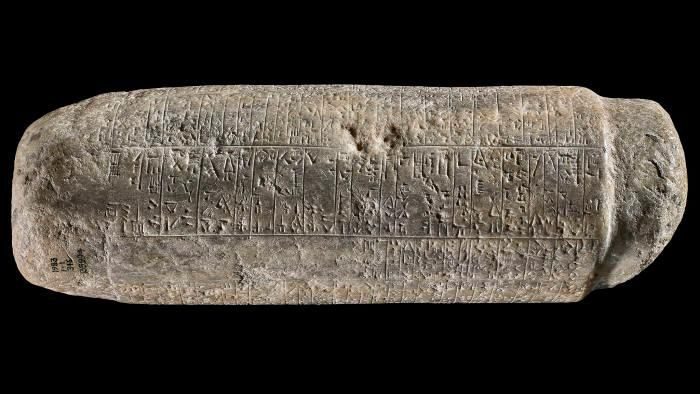A recently interpreted 4,500-year-old marble pillar from ancient Mesopotamia shows that even at the dawn of civilization, people were bickering about their borders.
As James Pickford at The Financial Times reports, the pillar sat in British Museum for 150 years until Irving Finkel, a curator in the Middle East department, deciphered the Sumerian cuneiform writing on the cylinder this year. As it turns out, the object, now on view in an exhibit called "No Man's Land," was erected to establish a border between the warring city states of Lagash and Umma, located in present-day southern Iraq.
According to the museum, the two cities were disputing over a fertile area called Gu'edina or the 'Edge of the Plain.' Around 2400 B.C. Enmetena, king of Lagash, had the pillar erected to stake his claim to the territory. Rachel Campbell-Johnston at The Times reports it is likely the earliest written evidence of a border dispute and is also the first time the term "no man's land" is used.
A ceremonial mace head made for Gishakidu, king of Umma, and Enmetena's foe, is also on display, as well as the Ur Plaque, which illustrates the offerings both cultures made at a border shrine.
The marble pillar's "glistening surface," which "would have shone out brightly and assertively under the sun beating down on the plain," according to the museum, wasn't just a roadside sign marking Lagash's territory. It is a heavily inscribed object, telling the complete story of the war between the two cities over the land. It also includes what may be the earliest-known example of written word play. Whoever chiseled the pillar didn't just take pains to emphasize the name of the Lagash god Ningirsu, substituting some of the cuneiform marks in the name with the symbol for god, they also threw some shade on the rival god of Umma, writing the god's name in a messy, almost illegible script.
"You have in one breath the use of writing in a magical way to enhance the power of one deity and then nullify the power of the other. This is unique in cuneiform. It's the most exciting thing you can imagine," Finkel tells Pickford at The Financial Times.
Finkel believes the pillar was artificially aged by a scribe to improve Lagash's historical claim to Gu'edina. It appears the scribe also used an archaic form of cuneiform to make the pillar seem older, which made the modern interpretation effort difficult.
The fight between Umma and Lagash is one of the oldest known wars in human history and led to what may be the world's first peace treaty and one of the oldest legal documents, the Treaty of Mesilim, signed around 2550 B.C. The treaty set up a border that was demarcated with a stele along an irrigation canal, similar to the one on view in the museum.
The peace did not last. Around 2400 B.C., the war between Enmetena and Gishakidu took place, and the boundary was reaffirmed. Eventually, Umma attacked Lagash and successfully destroyed its capital city of Girsu, not long before Sargon the Great took over all of Mesopotamia, paying no heed to even the snarkiest of boundary stones.
Jason Daley is a Madison, Wisconsin-based writer specializing in natural history, science, travel, and the environment. His work has appeared in Discover, Popular Science, Outside, Men's Journal, and other magazines.@jasondaley608




Reader Comments
to our Newsletter